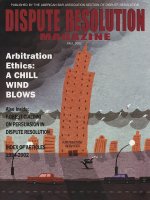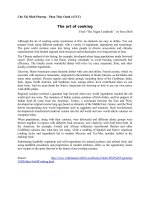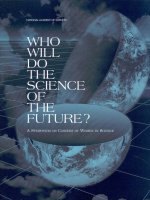- Trang chủ >>
- THPT Quốc Gia >>
- Hóa
The science of cooking
Bạn đang xem bản rút gọn của tài liệu. Xem và tải ngay bản đầy đủ của tài liệu tại đây (3.18 MB, 10 trang )
Genre
Nonfiction
Comprehension Skill
Compare and
Contrast
Text Features
• Captions
• Diagram
• Glossary
Science Content
Light and Heat
Scott Foresman Science 6.18
ISBN 0-328-14023-6
ì<(sk$m)=beacdh< +^-Ä-U-Ä-U
Vocabulary
Extended Vocabulary
conduction
conductor
convection
heat
insulator
radiation
reflection
refraction
thermal energy
braise
denaturing
fluid
immersed
Maillard reactions
porous
salmonella
Picture Credits
Every effort has been made to secure permission and provide appropriate credit for photographic material.
The publisher deeply regrets any omission and pledges to correct errors called to its attention in subsequent editions.
Photo locators denoted as follows: Top (T), Center (C), Bottom (B), Left (L), Right (R), Background (Bkgd).
1 Getty Images; 5 Ghislain & Marie David de Lossy/Getty Images; 12 (BL) Corbis; 14 (BR) Getty Images;
15 ©Ramon Manent/Corbis.
Unless otherwise acknowledged, all photographs are the copyright © of Dorling Kindersley, a division of Pearson.
ISBN: 0-328-14023-6
Copyright © Pearson Education, Inc. All Rights Reserved. Printed in the United States of America.
This publication is protected by Copyright, and permission should be obtained from the publisher prior to any
prohibited reproduction, storage in a retrieval system, or transmission in any form by any means, electronic,
mechanical, photocopying, recording, or likewise. For information regarding permission(s), write to
Permissions Department, Scott Foresman, 1900 East Lake Avenue, Glenview, Illinois 60025.
3 4 5 6 7 8 9 10 V010 13 12 11 10 09 08 07 06 05
What did you learn?
1. What are the three types of heat transfer used
in cooking?
2. In general, what kinds of materials are good
conductors?
3. What is happening when you boil water?
by Sarah Bright
4.
Most ways of cooking use a
combination of methods of heat transfer. What
single way of cooking is most important in your
household? What methods does it use?
5.
Compare and Contrast Compare two
different methods of cooking that use
different forms of heat transfer. What are
the advantages and disadvantages of each
of these methods?
What You Already Know
The particles that make up matter are always in motion. They
have kinetic and potential energy. The total kinetic and potential
energy in a substance is called thermal energy.
Thermal energy determines how warm a substance feels.
Warm liquids have more thermal energy than cool ones. The
particles in warm water move more quickly, and with more
kinetic energy, than those in cold water. Thermal energy can move
from one substance to another. This is known as heat. Heat will
always move from something that is warmer to something that is
cooler. Conduction, convection, and radiation are the three ways
thermal energy can be transferred. If two objects touch, the
transfer of thermal energy is called conduction. Energy gets
passed from particle to particle. The transfer of thermal energy by
liquid or gas is called convection. This results in a stream of fluid
called a convection current. If thermal energy is transferred by
waves, either through matter or space, it is called radiation.
A material can be either an insulator or a conductor. An
insulator does not transmit heat easily. Liquids and gases are
usually good insulators because their particles are farther apart.
Other materials, especially metals, are conductors. They transmit
heat easily. Have you touched a cold car door on a winter day, or
a metal spoon in a hot bowl of soup? You know that metal
conducts heat very well.
Waves of solar radiation hit Earth every day. Some radiation
is absorbed and warms Earth. Reflection occurs when radiation
travels back into space.
Sound waves are compression waves; they travel through
matter. Light travels as a transverse wave. It can travel through
empty space, and can travel through or be absorbed by matter.
Light travels slowest through solids, faster through liquids, and
fastest through gases. It also changes speed when it moves from
one direction to another. This is known as refraction.
Understanding the science of heat transfer helps you learn
how to cook foods properly. Depending on the method we use,
food can taste better, cook faster, and retain more of its
nutritional value. In this book you will learn about heat
sources, cooking methods, and chemical interactions that
occur when preparing food.
Metal frying pans are
good conductors of heat.
2
3
Heat and Cooking
Some raw foods are good
for us. But much of the food
we eat should be cooked. Food
often tastes better and is more
easily digested when it is
cooked correctly. Bacteria called
salmonella, which can cause
infections in the digestive
system, sometimes grow inside This woman is
demonstrating an early
raw eggs and meat. Cooking
cooking method using
food kills these and other
a clay oven.
harmful bacteria.
Cooking involves the transfer of thermal
energy. Thermal energy can be transferred by
conduction, convection, and radiation. Thermal
energy that moves from one substance to another
is called heat. Heat can cause chemical reactions
in foods.
In 1912 a French chemist named Louis
Camille Maillard discovered that all foods go
through a browning process at temperatures
above 154ºC (310ºF). This process, known as the
Maillard reactions, is a series of chemical reactions
between sugars and proteins that produces a
brown color and a taste that most people enjoy.
Sugar undergoes a chemical change when it is
heated above 154ºC. It breaks down and changes
from a solid to a thick brown liquid you
probably know as caramel.
Increasing heat also makes it easier to mix
things. Tea and coffee are examples of mixtures
that are much easier to make with hot water than
with cold water.
4
People have been cooking since the discovery of fire more
than 500,000 years ago. Early humans cooked over an open
fire; it was the only heat source available to them. Over the
years people have sought to prepare safe, good-tasting food
faster and more conveniently. To do this, people had to learn
how to use heat. Today slow cookers, or crockpots, work for
people who want food to cook over a long period of time,
while microwaves cook food very quickly.
Today barbecuing is a good way to cook food. Is it really that different
from how our ancestors cooked their food thousands of years ago?
5
Cooking With
Conduction
One method of cooking is by conduction. Conduction
occurs when a piece of matter that is hot comes in direct contact
with matter that is cooler. Thermal energy naturally moves from
hot matter toward matter that is less hot. In order to cook by
conduction, food has to come in contact with a hot surface.
Frying and braising are common methods of cooking using
conduction. When you fry, food comes in contact with the pan,
which is in direct contact with the heat source. When you braise,
food is cooked slowly in a closed pot using fat or oil.
Stir-frying is a form of conduction cooking that brings food into
direct contact with a heat source in order to cook it quickly.
Some materials are poor conductors
of heat. Glass, wood, plastic, and water
do not conduct heat well. Suppose
you are stirring a pot of boiling
water with a wooden spoon.
Wood is a poor conductor, so
the thermal energy from
the water does not travel up the spoon,
and your hand does not get too hot. But
metals are excellent conductors. Metal
pots and pans transfer heat to food easily.
Food scientists test different types
of cooking utensils and cookware to see
which work best in recipes. In fact, on
the back of a muffin mix, you will often
see different instructions for cooking times
and temperatures when using different
types of pans.
Since wooden skewers
are poor conductors,
you can use them
to handle hot food
without getting burned.
Which melts first?
Find a metal spoon, a plastic spoon, a wooden spoon, and
a straw. Stand them in a cup. Stick a frozen pea to the
end of each one with an equal amount of butter, which
acts as a sort of glue. Pour warm water into the cup and
see which pea falls off first.
pea on
This will tell you which
butter
instrument conducted
heat the fastest to melt
the butter.
6
7
Convection Currents
Convection is the transfer of thermal energy by a moving
fluid, such as air or water. The circular patterns created by this
movement are called convection currents. When a fluid gets
hot it has less density. It will rise above cooler fluids. A cooler
fluid is heavier and sinks below the warmer fluid, taking its
place. This means that there is a continuous, moving current of
rising and falling fluids, which cook the food. To cook by
convection, food needs to be immersed in fluid. Boiling is an
example of convection cooking; stewing and deep-frying are
other methods. Special convection ovens use fans to circulate
hot air and cook food faster.
Soup is simmered rather
than boiled. Simmering
requires a lower
temperature than boiling.
8
Circulation
Convection currents occur because heated oil becomes lighter
and rises to the top of the bowl. As the oil cools it sinks to the
bottom, creating continuous currents, or circulation. The blue
food coloring in the bowl shows the circulation taking place.
cooking oil
food
coloring
When you heat a pan of water until it boils, you are
causing convection currents that distribute heat throughout
the pot. The boiling point of water occurs when it reaches
a temperature of 100°C (212°F). Under normal pressure,
the temperature of liquid water never rises above 100°C
(212°F), no matter how much heat is applied. Boiling can
deliver heat to food faster than any other cooking method.
Deep-frying cooks food in much the same way as boiling.
Hot oil surrounds a food. Water that is at the surface of
the food turns to gas in the presence of the hot oil. As the
water vapor leaves the food, oil from the outside gets in.
9
Heat Radiation
Radiation is yet another
method used in cooking.
Radiation is energy traveling as
electromagnetic waves. When
you feel sunlight on your skin,
you are experiencing radiation.
Your food does not have to be
Microwaving cooks
in contact with a hot surface or
food faster than other
surrounded by a fluid when using
cooking methods.
radiation. A microwave oven
cooks by radiation. In grilling and barbecuing, foods absorb
the infrared radiation given off by the hot coals.
Unlike other methods of heating and cooking, radiation
can occur in empty space. It does not rely on matter to transfer
energy. This explains how the Sun’s heat can reach Earth. To
test this you can use radiation from the Sun to make sun tea.
The energy from the Sun’s rays warms the water by radiation.
The tea is brewed without boiling water.
Microwave ovens are perhaps the best-known example
of using radiation to cook. They are more efficient users of
energy than regular or conventional ovens. Invisible waves
called microwaves are produced by the oven. When they
strike water molecules in food, the molecules vibrate,
generating heat.
It is recommended to use only containers specially made
to microwave foods. Microwave-safe containers are made of
nonporous materials. Air molecules trapped in some
materials, such as ceramic, can get very hot.
Barbecuing absorbs infrared radiation
given off by the hot coals.
The Best Radiator
thermometer
Each of the jars on the right
is filled with hot water. After a
few minutes, the thermometer
shows that the water in the
black jar cools down more
quickly than the one covered
with foil. Why? Because the
black jar loses heat from
radiation, while the foil-covered
jar absorbs radiation.
10
tin foil
matte black
paint
11
Hard or Soft?
Many foods expand when heated
and contract when cooled. Think
about cookies. Bakers often shape
cookies into small balls and then
place them on a baking sheet. While
they are in the oven, the cookies
spread and become flatter as they
cook. Other foods change from a soft
state to a hard state. When you toast a
Butter changes from hard
slice of bread, it becomes hard. Bread
to soft as it melts.
contains carbohydrates, which are
chemicals made up of carbon,
hydrogen, and oxygen. When bread is toasted, the
carbohydrates break down into black carbon and water.
The carbon gives the bread a dark color and a crunchy
texture. The water escapes into the air.
Eggs can be prepared using different methods of cooking.
Whatever the method, cooking an egg will change the egg’s form.
Natural proteins in raw eggs exist in individual units. They are
wound up in very tiny coils. The coils are held tightly by bonds
within the molecules. When the protein is heated, some of the
bonds within the individual molecules are broken. The broken
bonds cause the protein to unwind, leaving the bonds exposed
and sticking out. This process is called denaturing. Then the
exposed bonds of the egg proteins come together, forming
a solid material. This is why
an egg turns solid white when
it is cooked.
Hard-boiling is one way
to cook an egg. Both
the white and the yolk
harden in the shell as
they are cooked.
Bread changes from soft
to hard as it toasts.
12
13
Temperatures
Some foods cook more quickly than
others do. This can depend on the kind
of liquid used for cooking. Every
substance has a particular boiling point.
For example, oil has a very high boiling
point; it is higher than that of water. Oil
is used in deep-frying, which is a very
quick way to cook a potato. It takes
longer to boil the potato in water. You
can even deep-fry ice cream! The ice
cream is covered with batter or
breadcrumbs. The crust cooks so quickly
that the ice cream doesn’t melt.
Jams and other foods with lots of
sugar have high boiling points. These
types of foods can be heated on a
stove, but if they reach their
boiling point, their
chemical composition
changes so much that
you may end
up with a
gooey mess.
Water boils
at 100˚C.
14
Cooking Science
Oil has a higher boiling
point than water.
Bread is baked in an oven using convection currents. It is one of
many foods that have been cooked in much the same way for
thousands of years.
There are three main ways to cook food: radiation,
convection, and conduction. Often cooking uses more than one
method. A pressure cooker cooks food using boiling water and
hot steam. It uses conduction and convection. Steaming uses
convection, while baking uses convection and sometimes
conduction. Grilling uses radiation and convection, while
microwaving uses radiation exclusively.
Food science helps us to discover and understand the
chemical changes food goes through when it is being prepared or
cooked. The more we understand the chemical processes we call
cooking, the more we will benefit from the foods that sustain us.
15
Vocabulary
Glossary
conduction
conductor
convection
braise
heat
insulator
radiation
denaturing
reflection
refraction
thermal energy
fluid
Extended Vocabulary
braise
denaturing
fluid
to cook in a closed pot over low heat using
immersed
fat or oil
Maillard reactions
porous
changing the chemical structure of a
salmonella
protein
1. What are the three types of heat transfer used
in cooking?
2. In general, what kinds of materials are good
conductors?
3. What is happening when you boil water?
a substance that lacks a definite shape such
as a liquid or a gas
immersed
completely surrounded by a fluid
Maillard reactions
a series of chemical reactions through
which food is browned
porous
full of small holes
salmonella
a type of bacteria that can cause infections
of the digestive system
Picture Credits
Every effort has been made to secure permission and provide appropriate credit for photographic material.
The publisher deeply regrets any omission and pledges to correct errors called to its attention in subsequent editions.
Photo locators denoted as follows: Top (T), Center (C), Bottom (B), Left (L), Right (R), Background (Bkgd).
1 Getty Images; 5 Ghislain & Marie David de Lossy/Getty Images; 12 (BL) Corbis; 14 (BR) Getty Images;
15 ©Ramon Manent/Corbis.
Unless otherwise acknowledged, all photographs are the copyright © of Dorling Kindersley, a division of Pearson.
ISBN: 0-328-14023-6
Copyright © Pearson Education, Inc. All Rights Reserved. Printed in the United States of America.
This publication is protected by Copyright, and permission should be obtained from the publisher prior to any
prohibited reproduction, storage in a retrieval system, or transmission in any form by any means, electronic,
mechanical, photocopying, recording, or likewise. For information regarding permission(s), write to
Permissions Department, Scott Foresman, 1900 East Lake Avenue, Glenview, Illinois 60025.
3 4 5 6 7 8 9 10 V010 13 12 11 10 09 08 07 06 05
16
What did you learn?
4.
Most ways of cooking use a
combination of methods of heat transfer. What
single way of cooking is most important in your
household? What methods does it use?
5.
Compare and Contrast Compare two
different methods of cooking that use
different forms of heat transfer. What are
the advantages and disadvantages of each
of these methods?









